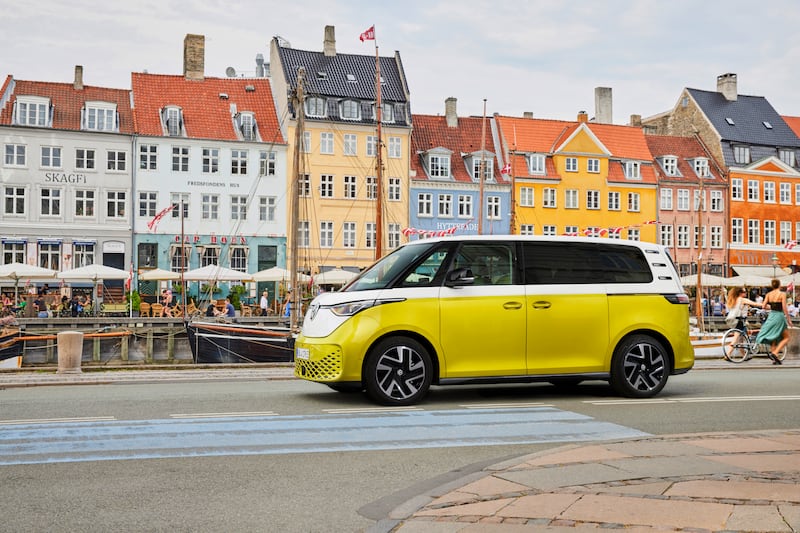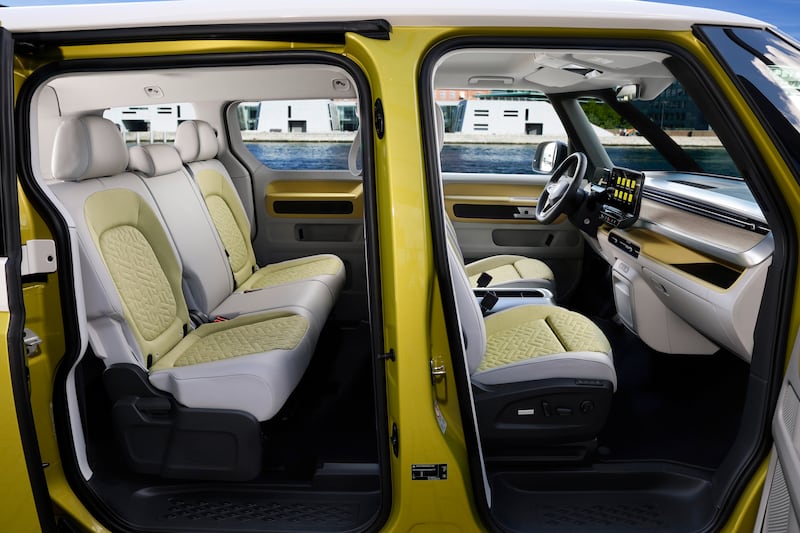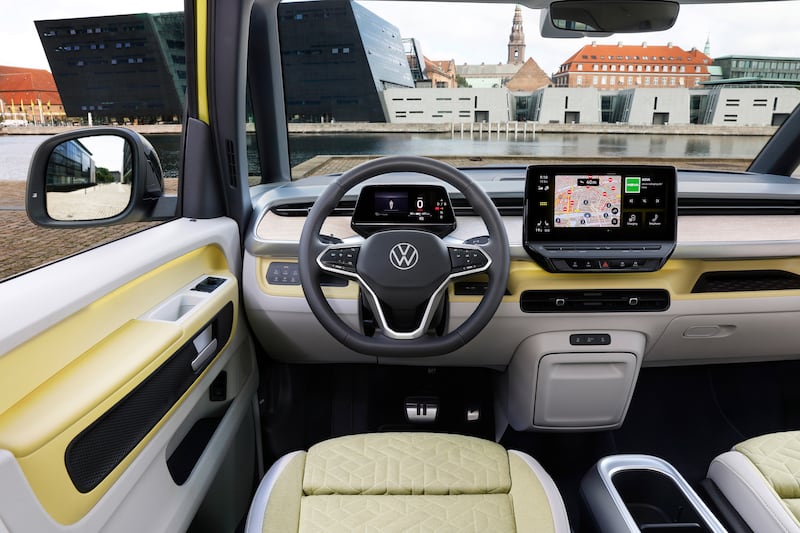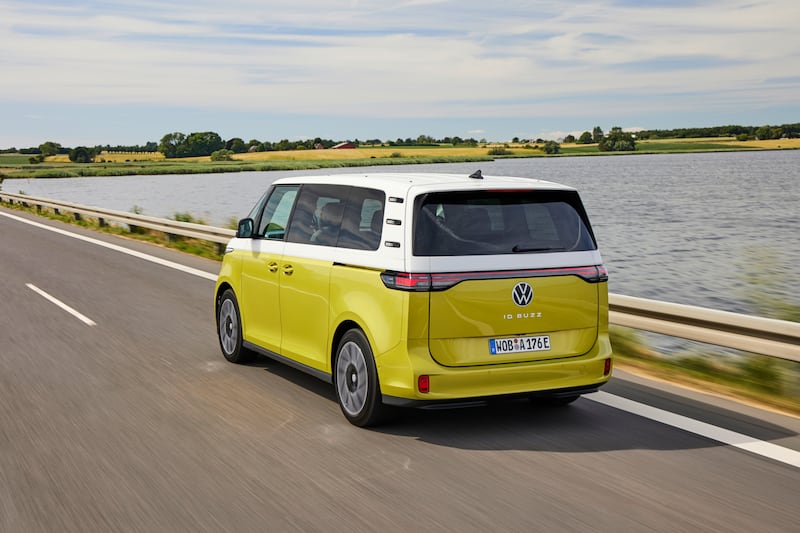VW certainly got the name right: there’s plenty of excitement for its new all-electric ID.Buzz. Playing on the retro appeal of its famous T2 minibus — or microbus — from the 1960s, head of Volkswagen design Jozef Kabaň describes the Buzz as a lovable, ultrapractical family car that delivers the levels of refinement you expect from a quality SUV, but without the aggressive persona.
In many ways VW is following a growing trend by car makers to create models that offer the sort of practicality buyers love about SUVs, but without the in-your-face styling touches that irk other road users.
VW clearly hopes the Buzz will be the motoring antidote to the growing ire against SUVs. In contrast with status-symbol SUVs, the Buzz has a charm that attracts complements rather than contempt from other road users. Certainly, testing the new VW around the streets of Copenhagen, it attracted numerous thumbs up from other motorists and cyclists. That contrasts with testing new SUVs, which tends to lead to other fingers of the hand being extended.
The warm public welcome for the Buzz suggests that VW has hit the right notes with its retro styling. What’s more, it’s clear that even for generations who weren’t born when the T2 rattled along the roads, there’s a warmth towards what it represented. There are a lot more hippies and hodads out there than you might expect.
READ MORE

True, the Buzz is a very modern take on that classic van. While that may mean touchscreen controls and battery power, it’s also in line with safety rules, so these days you can’t squeeze nine people, three dogs and a double bed into a small van with no seat belts or airbags and with ropey brakes.
Compared to the rattle and roll of the older van, this is a doddle to drive. It may look like a big and bulky affair from the photos, but it’s very manageable around town, thanks largely to a remarkably impressive turning circle. And the dimensions tell their own story: at 4.7m, it’s shorter than a Touareg SUV, while its height of just under 2m is lower than the current VW Multivan people carrier.
Inside, however, the Buzz lives up to its ancestor’s reputation as a hippy Tardis. In five-seater guise you get a massive 1,121 litres of bootspace with options to fit a double mattress and even a fold-out kitchen unit from the back.


Staying true to the T2 heritage, the ID.Buzz gets rear engine rear-wheel drive with front seats as close to the nose as you can get these days, given crash protection requirements. Built on VW’s impressive MEB platform, a 77kW battery pack powering a 204bhp electric motor drives the rear wheels. However, don’t expect the sort of surge you get in the likes of the ID.3 or other EVs. The Buzz engineers clearly prioritised range over racing away from the lights, so a sedate 0-100km/h time of 10.2 seconds underlines that there is no neck-snapping acceleration.
The benefit is reaped on the road, with a promised range of up to 425km between charges. Realistically, that’s likely to mean a mid-350km range based on the experience we’ve had with the rest of the VW EV models. During our time at the wheel, on a mix of motorway and town driving, we managed to hit the claimed consumption of 22kWh/100km.
There is good news on the charging front, with the ID.Buzz capable of taking up to 170kW on a DC fast charger, meaning you can get from 5 per cent to 80 per cent of battery capacity in 30 minutes.
The driving position is very SUV or van-like, which gives a great view of the road ahead. Similarly, rear-seat passengers get ample views out the large windows.
The interior trim matches many premium counterparts, and promises no animal products were used in the design. It has stuck with the same awkward swipe bar controls for volume and temperature but at least the software system has been updated, promising quicker response times and fewer glitches.
The ride quality is also substantially better than you’d expect from a traditional passenger van, helped of course by the floor-mounted battery pack that gives the ID.Buzz a lower centre of gravity, while the addition of multi-link rear suspension is a benefit to the vehicle’s handling, particularly in the commercial version dubbed the ID.Buzz Cargo.
There are rumours of a four-wheel drive ID.Buzz in the distant future, but of more importance will be the arrival of a larger battery pack — circa 90kW — which will feature in the longer wheelbase version.

That long wheelbase will herald the arrival of a seven-seat format. VW is adamant that its research shows the majority of buyers in this family market are looking for five seats and a big boot. I’m less convinced. Certainly the Irish family buyers we encounter are looking for the option of a third row. And given this car’s size they will be short-changed. All the more so when they see the price tag. The starting price for the Buzz, in five-seat passenger form is €65,890 for the basic Life model. That’s considerably more expensive than a comparable ID.4 or ID.3, using the same 77kWh battery. You do get a 10-inch touchscreen, a heated windscreen, LED lights and sat-nav but you’ll have to upgrade to an even pricier €70,460 Family model if you want heated seats, or a €72,055 Tech if you want 20-inch wheels and a powered tailgate.
It’s worth noting that the ex-VAT cost of the Buzz Cargo van (which can be had with a three-seat cabin) is €41,538, inclusive of the €3,800 commercial vehicle electric grant.
Pitch those passenger Buzz prices against the ID.4, which starts at €53,605 for its Life version; it’s a five-seater and while you have roughly half the bootspace of the ID.Buzz, it’s still an ample 543 litres, but for €12,285 less.
VW may have found itself at a crossroads when launching the ID.Buzz. Opt to start with the seven-seat format, thereby ticking the family function box and delivering a much-needed seven-seat option to the EV market, but at a starting price that would scare the children. Or opt to come in with a five-seat format at a lower price point. The brand chose the latter route, but I’m not sure that €65,000 makes it all that more amenable to the average family buyer. It’s certainly out of the price range of any cost-of-living crisis beatniks; it’s more for the higher-rolling hippie.














